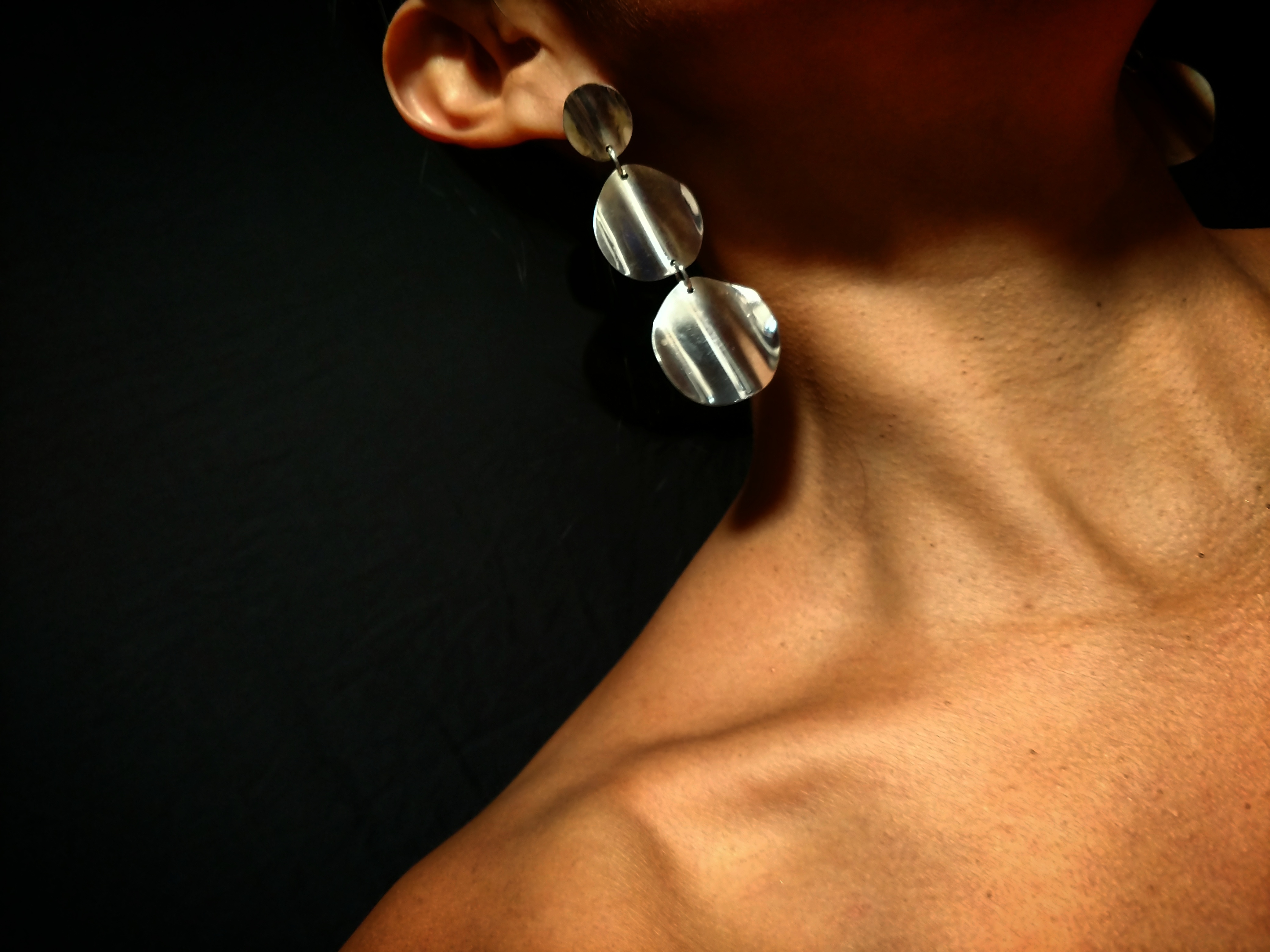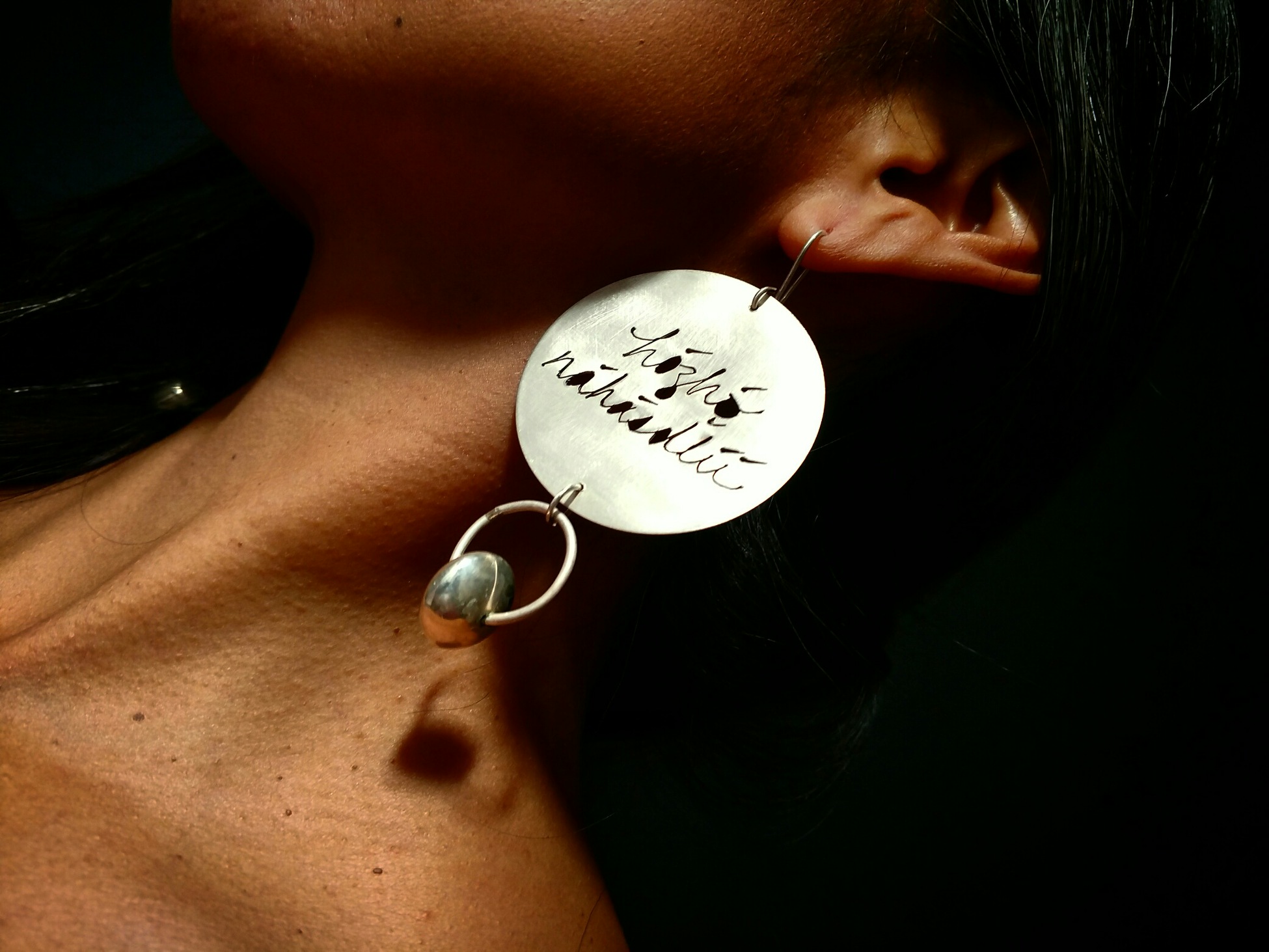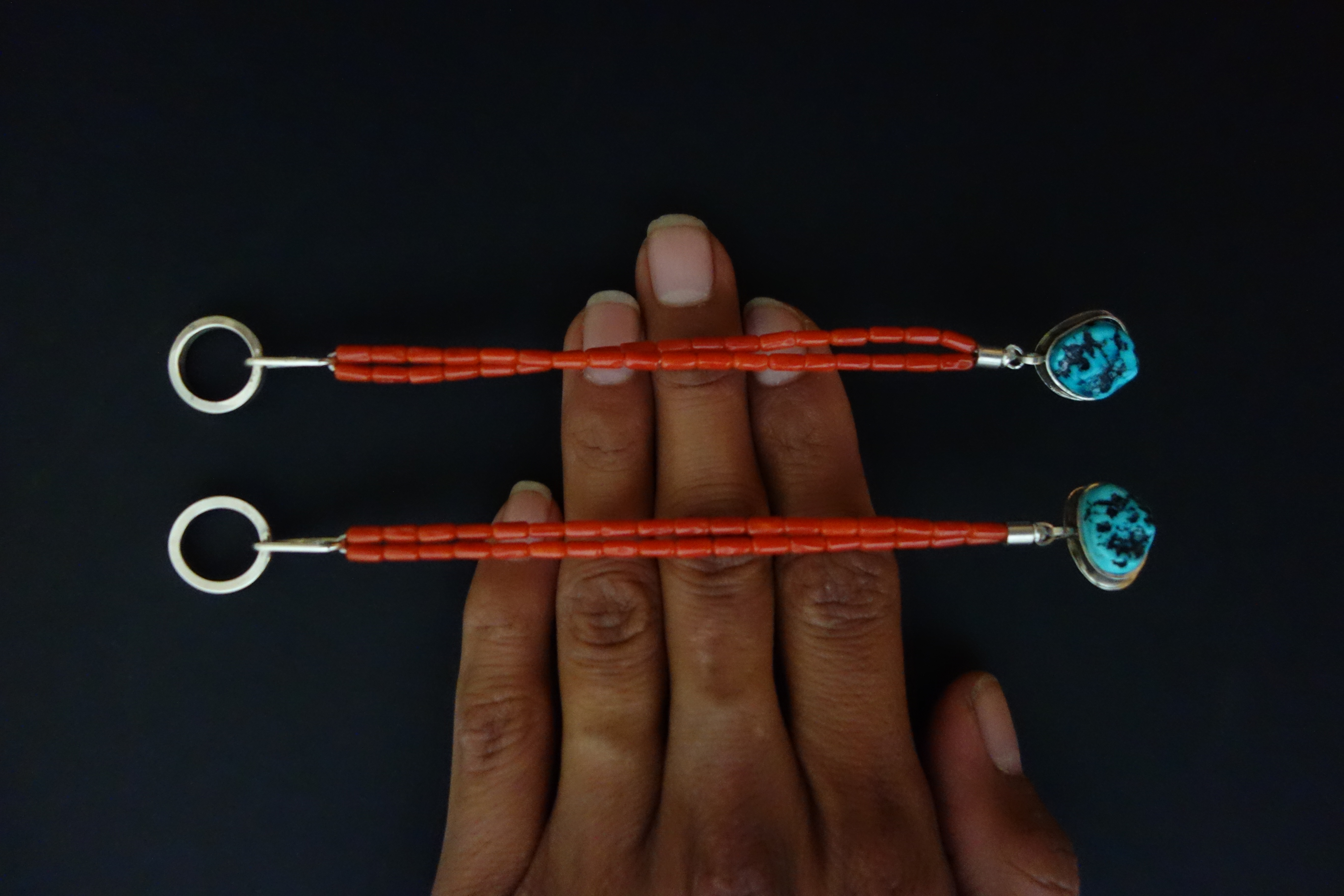The Native American community is one of the country’s most underappreciated. We all know of our nation’s appalling history with its indigenous people, but what we often forget to discuss is how the hundreds of Native tribes are living and thriving today. We spoke with First Nation jewelry designer Nanibaa Beck to discuss how she uses her label, NotAbove to celebrate her heritage and enlighten Americans.

SS: NOTABOVE is fairly new, just about three years old. Tell us a bit more about how you started designing jewelry, and what compelled you to take the leap into making this a full-fledged business.
NB: My father is a jeweler and I’d been assisting him since middle school. His motto for me and my relationship with jewelry has always been “you have to want to do it”; and I didn’t want to be a jeweler at that time. Instead, I took the route of being an academic and being involved with Native Art through internships and fellowships. I wanted to understand all the intricate parts of that world because I grew up observing it. As for what compelled me to make the leap into being a business, simply I finally believed in myself enough to do it. At the same time, my mom was creating her own jewelry and kept encouraging me. So, I had the knowledge, time, creative motivation, and support.
SS: Your jewelry has a very unique appeal; it’s minimal and simple, yet there’s clearly something more to each piece. What sort of things inspire you when you design these items?
NB: A collage of images comes to mind. I admire the clean lines that I see in my father’s early work to Kandinsky’s pieces. Sitting hours at a lapidary machine to form nuggets of natural stone into a necklace. Admiring art made by incredible Native artists interpreting their own style. Traveling by car to unassuming buildings to purchase quality stones and materials. Being a student reading academic articles on a variety of topics with Radiohead blaring. Attending family gatherings and ceremonies with my family. My family. My mom.
SS: Much of your work is clearly inspired by your Native American heritage. Given our country’s tumultuous history with its indigenous peoples, having such a strong identity has allowed your work to carry a deeper message. When did you decide you wanted to create pieces with such powerful cultural significance?
NB: For me, my background is rich in tradition and my family’s love guides me. My world consists of family and friends all of whom possess an array of personalities and abilities. At the core, our daily conversations connect through k’é and hózhó. The source of our tradition continued and is not defined within a timeframe; it moves with every generation. I see that we are still the purveyors of our culture and protectors of our land. So, I try to be mindful of how to interact with that knowledge. My creativity happens to be that outlet for me. This is just how it is.

Processed with VSCO with e1 preset
SS: How did you go about tying in your own heritage to the designs and items you would create?
NB: Well, it is informed by personal experiences. For example, I’m still learning how to speak my language and try to use it as often as I can, even risking embarrassment for mispronouncing a word. So, when I wanted to make Ahéhee’ (Thank you) cards, it led to an a-ha moment that would solidify my business acumen of being culturally sustainable. I’m fortunate to be surrounded by fluent speakers and I understand the complexities that other tribes feel when it comes to their language. I felt that by creating jewelry with indigenous languages, it could encourage conversations and add depth to our daily lexicon beyond English. And, it did. When we write, or say words in our language, it is felt so deeply. I’ve seen how it touches people to the core. I see my work as part of a generation of people who aim to keep our tradition vibrant and relevant. I am at the core a Diné woman of Ta’neeszahnii, born for Tł’izi lani, my maternal grandfather’s clan is Tsé deeshgizhnii, and my paternal grandfather’s clan is ‘Áshįįhi. It is in me to create from all who have come before me and surround me today. I see my pieces as an innate reflection of how I choose to honor them.
SS: Do you feel that your platform and your work has made you somewhat of an activist for the Native American community?
NB: (smiles) It could be described as activism but I think being a Native person means we are also inherently political. I am very passionate about the continuation and positive representation of my people, as are the people that I surround myself with. We all share a beautiful sense of preservation and perseverance because our indigenous existence was not meant to flourish and yet it did. So, I am thankful to my k’é’ for sharing what makes them resilient. It took years of observations, conversations, reading, writing, and participating to get where we are as indigenous people, and I love that it continues to grow into something intentionally beautiful. To not be inspired and motivated by that energy would be a fallacy to our ancestors and future generations.
SS: What specific aesthetic elements, philosophical principles, or other things do you try to emphasize in order to promote your culture through your work?
NB: I try to keep my promotion as real as possible and to have people experience nizhóní (beauty) right along with me. So, I share how I am empowered by Diné words like hózhó and k’é. Hózhó is a complex concept of harmony and beauty that I referenced in an earlier answer. K’é simply refers to family and friends, as well as referencing all the characteristics that describe friendship- loyalty, nurturing, respectful, supportive, caring, considerate and more. Aesthetically, I love the balance of asymmetry. I encourage glimpses to the type of music I listen to while I work. And for people to see what my home life looks like. In the end, my work can resonate with anyone.
SS: The fashion industry in particular has had several instances of cultural appropriation, especially regarding Native American culture. What would you hope to do – or suggest that the industry should do – to combat this problematic recurrence?
NB: I suggest companies be aware of the location from which Native-inspired items are being produced. Usually, the native appropriation begins at a non-indigenous company, away from the original people who inspired them. Usually, these companies choose the stereotypical and fantastical parts of 560+ living Native tribes and nations to create a profit. These items are devoid of the vibrant cultural connotations of people that still exist today and play into a false narrative that disregards their humanity. It does no honor when it’s worn by a celebrity or in photo shoot, or as a costume. By now, we know the fashion industry is a fast and ever-changing machine with trends fluctuating all the time. It has proven difficult to change some perspectives. Yet, some are moving from Native-inspired to working alongside Inspired Natives. Christi Belcourt’s work with Dior is a wonderful example of how to approach a collaboration with Native artists. Paul Frank teamed up with Beyond Buckskin’s Jessica Metcalfe to produce a line created by Native artists. Beyond Buckskin is a Native-owned business that promotes, connects, and supports Native-owned business and native made work. Bethany Yellowtail’s Collective, is a group that she gathered to promote handmade, well-crafted quality pieces. And I see OXDX and other streetwear designers participating in a form of artivism with their work. Little by little, the efforts of these proactive artists and organizations are providing a way for the fashion industry to be more inclusive of handmade Native-made work.

SS: What do you see as some of the most pressing issues facing the Native American communities across the nation today? How do you hope to draw attention to these issues and increase awareness through your craft?
NB: There are many issues, so I will focus on the #NoDAPL (No Dakota Access Pipeline) movement taking place at the Standing Rock Sioux reservation, south of Bismarck, ND. Bismarck residents did not want the Dakota Access Pipeline to run anywhere near their town so it was redirected to run alongside a tribal reservation. This would endanger their primary water source. The people standing against the pipeline’s construction and its militaristic forces are nonviolent Protectors (not protestors) of the water. This peaceful movement has been growing over the past year to stand in solidarity to major injustices happening to Standing Rock People. It is a combination of continued disrespect of Native people by ignoring treaty rights, destroying sacred sites, fear mongering, and more. Pipelines are not everlasting; it will leak at some point. Furthermore, the Missouri river is a primary water source with tributaries that provide water to millions of people, both native and non-native people. We inherited this land to keep it safe for our future generations. Water is life, so we must protect it. More information and updates can be found at the Indigenous Environmental Network Facebook page. So, in my humble way, I am donating a portion of the proceeds from my Language collection to support their efforts. I created tó éí iiná (water is life) earrings to honor the continued efforts of my k’é who stand in solidarity with the Protectors.
SS: What would you hope that your work can help expose to Americans who may not truly understand the various Native American cultures? How would you like to see the majority of Americans’ thoughts or opinions regarding Native American culture change?
NB: When non-Natives see my work, they will see the Southwest and think all Native American jewelry must have turquoise or silver. Or some will see it as not traditional. I like to remind non-Natives that Native American jewelry is regionally diverse as are the ways we interpret what traditional means to us individually. As for changing opinions, there is so much. So, simply, I will say I’m aware we, Natives and non-Natives, exist in our own lives set in certain surroundings today. A certain sense of Native tradition and growth can’t be easily conveyed since it lies in part of the history this country didn’t teach many Americans. So, some will not change their opinions of Natives, period. But for others willing to learn and share, I know it is important to nurture these relationships and be inclusive in our communication. In this way, I do feel a creative energy resonating around Native perseverance. I think everyone is at a different point of growth in their life but collectively we are acting on something beautiful. I can only be optimistic, have patience, and continue growing as a Diné woman.
SS: What do you hope to achieve through your work, whether on a business level, regarding editorial coverage, or on a larger, more activist-focused scale?
NB: I hope that my work continues to resonate with Native communities. Whatever coverage that it receives, I hope people interact with the work for its visual appeal and understand that it was created from a consciously hózhó-powered viewpoint. I hope other Natives and more non-Natives are drawn it to because it serves a culturally sustainable purpose of learning and sharing. This is my act of ha’íínl’ní (perseverance).

All photos by Nanibaa Beck and Jeff Slim
Editor’s note: Each piece pictured has a unique significance:
Waves – Nanibaa’s late mother taught her how to make her Waves earrings.
To Ei Iina: Water Is Life
Hozho Nahasdlii: Walk in Beauty
Hozho: a complex concept that refers to harmony and balance.
To see the full story, get your copy of Phosphenes #2 – Americana.